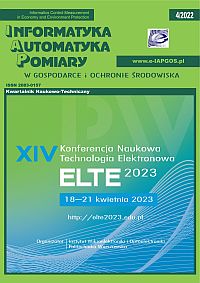Aras A. et al.: Dimensional changes of the nasal cavity after transpalatal distraction using bone-borne distractor: an acoustic rhinometry and computed tomography evaluation. J. Oral Maxillofac. Surg. 68(7), 2010, 1487–1497.
DOI: https://doi.org/10.1016/j.joms.2009.09.079
Avrunin O. G. et al.: Features of image segmentation of the upper respiratory tract for planning of rhinosurgical surgery. Paper presented at the 2019 IEEE 39th International Conference on Electronics and Nanotechnology, ELNANO 2019, 485–488.
DOI: https://doi.org/10.1109/ELNANO.2019.8783739
Avrunin O. G. et al.: Principles of computer planning in the functional nasal surgery. Przeglad Elektrotechniczny 93(3), 2017, 140–143 [http://doi.org/10.15199/48.2017.03.32].
DOI: https://doi.org/10.15199/48.2017.03.32
Avrunin O. G. et al.: Study of the air flow mode in the nasal cavity during a forced breath. Proc. of SPIE 10445, 2017 [http://doi.org/10.1117/12.2280941].
DOI: https://doi.org/10.1117/12.2280941
Avrunin O. G. et al.: Possibilities of Automated Diagnostics of Odontogenic Sinusitis According to the Computer Tomography Data. Sensors 21, 1198, 2021 [http://doi.org/10.3390/s21041198].
DOI: https://doi.org/10.3390/s21041198
Berger M. et al.: Agreement between rhinomanometry and computed tomography-based computational fluid dynamics. International Journal of Computer Assisted Radiology and Surgery 16(4), 2021, 629–638 [http://doi.org/10.1007/s11548-021-02332-1].
DOI: https://doi.org/10.1007/s11548-021-02332-1
Cankurtaran M. et al.: Acoustic rhinometry in healthy humans: accuracy of area estimates and ability to quantify certain anatomic structures in the nasal cavity. Ann Otol. Rhinol. Laryngol. 116(12), 2007, 906–916.
DOI: https://doi.org/10.1177/000348940711601207
Churchill S. E. et al.: Morphological Variation and Airflow Dynamics in the Human Nose. Am. J. Of Hum. Biol. 16, 2004, 625–638.
DOI: https://doi.org/10.1002/ajhb.20074
Cilluffo G., et al.: Assessing repeatability and reproducibility of anterior active rhinomanometry (AAR) in children. BMC Medical Research Methodology 20(1), 2020 [http://doi.org/10.1186/s12874-020-00969-1].
DOI: https://doi.org/10.1186/s12874-020-00969-1
Clement P. A.: Standardisation Committee on Objective Assessment of the Nasal Airway. Consensus report on 43, 2005, 169–179.
Fyrmpas G. et al.: The value of bilateral simultaneous nasal spirometry in the assessment of patients undergoing. Rhinology 49(3), 2011, 297–303.
DOI: https://doi.org/10.4193/Rhino10.199
Hsu Y. et al.: Role of rhinomanometry in the prediction of therapeutic positive airway pressure for obstructive sleep apnea. Respiratory Research 21, 2020, 115 [http://doi.org/10.1186/s12931-020-01382-4].
DOI: https://doi.org/10.1186/s12931-020-01382-4
Kang Y. J. et al.: The diagnostic value of detecting sudden smell loss among asymptomatic COVID-19 patients in early stage: The possible early sign of COVID-19. Auris Nasus Larynx 47(4), 2020, 565–573 [http://doi.org/10.1016/j.anl.2020.05.020].
DOI: https://doi.org/10.1016/j.anl.2020.05.020
Kirichenko L. et al.: Machine learning in classification time series with fractal properties. Data 4(1), 2019, 5 [http://doi.org/10.3390/data4010005].
DOI: https://doi.org/10.3390/data4010005
Kuo C. J. et al.: Application of intelligent automatic segmentation and 3D reconstruction of inferior turbinate and maxillary sinus from computed tomography and analyze the relationship between volume and nasal lesion. Biomedical Signal Processing and Control 57, 2020, 101660 [http://doi.org/10.1016/j.bspc.2019.101660].
DOI: https://doi.org/10.1016/j.bspc.2019.101660
Li C. et al.: Nasal structural and aerodynamic features that may benefit normal olfactory sensitivity. Chemical Senses 43(4), 2018, 229–237.
DOI: https://doi.org/10.1093/chemse/bjy013
Mlynski G. et al.: Correlation of nasal morphology and respiratory function. Rhinology 39(4), 2001, 197–201.
Moghaddam M. G.et al.: Virtual septoplasty: A method to predict surgical outcomes for patients with nasal airway obstruction. International Journal of Computer Assisted Radiology and Surgery 15(4), 2020, 725–735 [http://doi.org/10.1007/s11548-020-02124-z].
DOI: https://doi.org/10.1007/s11548-020-02124-z
Ohlmeyer S. et al.: Cone beam CT imaging of the paranasal region with a multipurpose X-ray system-image quality and radiation exposure. Applied Sciences 10(17), 2020, 5876 [http://doi.org/10.3390/app10175876].
DOI: https://doi.org/10.3390/app10175876
Ott K.: Computed tomography of adult rhinosinusitis. Radiologic Technology 89(6), 2018, 571–593.
Paul M. A. et al.: Assessment of functional rhinoplasty with spreader grafting using acoustic rhinomanometry and validated outcome measurements. Plastic and Reconstructive Surgery – Global Open. 6(3), 2018, p e1615 [http://doi.org/10.1097/GOX.0000000000001615].
DOI: https://doi.org/10.1097/GOX.0000000000001615
Pavlov S. V. et al.: Information Technology in Medical Diagnostics. CRC Press, 2017.
Radulesco T. et al.: Correlations between computational fluid dynamics and clinical evaluation of nasal airway obstruction due to septal deviation: An observational study. Clinical Otolaryngology 44(4), 2019, 603–611 [http://doi.org/10.1111/coa.13344].
DOI: https://doi.org/10.1111/coa.13344
Romanyuk S. et al.: Using lights in a volume-oriented rendering. Proc. of SPIE 10445, 2017, 104450U.
Rovira J. R. et al.: Methods and resources for imaging polarimetry. Proc. of SPIE 8698, 2012, 86980T.
DOI: https://doi.org/10.1117/12.2019732
Tang H. et al.: Dynamic Analysis of Airflow Features in a 3D Real-Anatomical Geometry of the Human Nasal Cavity. 15th Australasian Fluid Mechanics Conference, University of Sydney, Australia, 2004.
Toriumi D.M.: Assessment of rhinoplasty techniques by overlay of before-and-after 3D images. Facial Plast Surg Clin North Am. 19(4), 2011, 711–723.
DOI: https://doi.org/10.1016/j.fsc.2011.07.011
Valtonen O. et al.: Three-dimensional printing of the nasal cavities for clinical experiments. Scientific Reports 10, 2020, 502 [http://doi.org/10.1038/s41598-020-57537-2].
DOI: https://doi.org/10.1038/s41598-020-57537-2
Vogt K., Jalowayski A. A.: 4-Phase-Rhinomanometry Basics and Practice. Rhinology 21, 2010, 1–50.
Wójcik W., Pavlov S., Kalimoldayev M.: Information Technology in Medical Diagnostics II. London: Taylor & Francis Group, CRC Press, Balkema book, 2019.
DOI: https://doi.org/10.1201/9780429057618
Zhang G. et al.: Correlation between subjective assessment and objective measurement of nasal obstruction. Zhonghua 43(7), 2008, 484–489.







